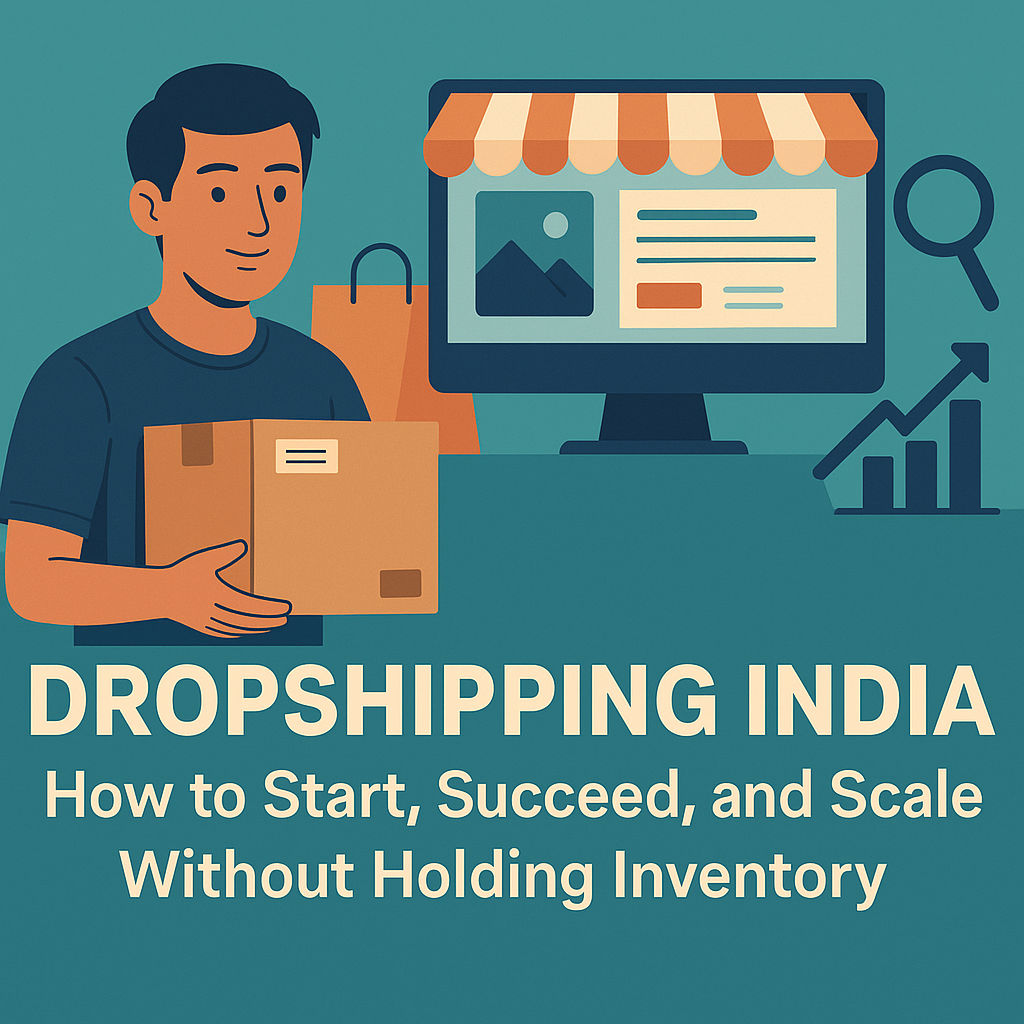Table of Contents
A Personal Account of Taking the Risk

I still remember the day I heard the term “dropshipping India.” It was during the lockdown. Money was tight, jobs were uncertain, and I was desperately looking for something I could start from home. No warehouse. No inventory. Just a laptop and some courage. That’s when I stumbled upon a Reddit thread where someone claimed to make ₹1 lakh per month just by dropshipping products from Chinese suppliers to Indian customers using Shopify and Facebook ads.
Skeptical but curious, I dug deeper.
What I discovered changed my perspective on online business. Dropshipping India wasn’t just possible — it was growing. In fact, according to Statista, India’s e-commerce market is projected to reach over $350 billion by 2030, and a big part of that is powered by models like dropshipping.
This article breaks down exactly how dropshipping India works, why it’s gaining popularity, real case studies, challenges, legal aspects, and strategies to win in 2025 — written by someone who’s been through the process.
What is Dropshipping in India and How Does It Work?
Let’s break this down for beginners. Dropshipping India is a business model where you, the seller, do not keep any products in stock. Instead, when a customer places an order, you forward the order to a third-party supplier (like Alibaba, GlowRoad, or Meesho), who then ships the product directly to the customer.
You earn the margin between the wholesale cost and the price you sell it for.
The simplicity is attractive. No warehouse. No packaging. No inventory risk.
However, in the context of dropshipping India, local logistics, customer trust, and payment gateways like Razorpay or Cashfree become key parts of the system.
Many Indian dropshippers start with platforms like:
- Shopify (connects with Oberlo or CJ Dropshipping)
- WooCommerce (for WordPress users)
- Dukaan app (India-specific)
- Meesho (reseller/dropshipping hybrid)
There are dozens of YouTube tutorials explaining this (one good one is this beginner guide).
Real-Life Success: From ₹0 to ₹10 Lakh with a Single Product
Let me share the story of Harsh, a college dropout from Delhi who scaled dropshipping India with a simple product: a posture corrector.
He found a supplier on Alibaba, created a Shopify store, and ran Instagram influencer ads. His costs:
- Product (with shipping): ₹220
- Selling Price: ₹899
- Ad Spend: ₹300 per sale
- Profit per unit: ₹379
He sold over 3,000 units in three months.
Was it easy? No. His first store failed. His second had payment gateway issues. But once he fixed the basics, dropshipping India clicked.
What helped?
- Fast delivery (used local suppliers via IndiaMART)
- Responsive WhatsApp support
- Good product videos
You can follow people like Harsh on LinkedIn or forums like StartupTalky where dropshippers share case studies.
Is Dropshipping Legal in India? Clearing the Confusion
Yes, dropshipping India is legal — but it must comply with taxation and consumer protection laws.
Here’s what you need:
- GST Registration: Required if your turnover exceeds ₹20 lakh per year or if you’re selling interstate.
- Import Rules: If using Chinese suppliers, make sure to comply with DGFT norms and BIS certifications.
- Payment Gateway KYC: Gateways like Razorpay require business verification, bank account, PAN, and proof of website.
If you’re using Indian suppliers (like GlowRoad or Shop101), your legal work is much simpler.
There’s a helpful blog on LegalWiz explaining this process.
Also, remember — returns and refunds are your responsibility as the seller. So if the supplier messes up, you have to own it.
The Best Products to Start Dropshipping in India in 2025
If you’re thinking of starting dropshipping India, picking the right product is 70% of the game. Based on current trends and my experience, here are categories that work well:
- Health & Wellness: Posture correctors, neck massagers, herbal oils
- Home Decor: LED lights, space-saving furniture tools
- Personal Gadgets: Mini humidifiers, wireless earphones, smartwatches
- Pet Accessories: Grooming kits, interactive toys
- Fashion Accessories: Watches, sunglasses, ethnic jewelry
Use Google Trends, Amazon bestseller pages, and tools like Sell The Trend to identify winners. For example, this Google Trend shows the rise in smartwatch searches in India.
Dropshipping India is all about picking products with emotional appeal, low competition, and high perceived value.
Platforms and Tools You Need to Launch a Dropshipping Store in India
When I started dropshipping India, I didn’t know which tools to trust. Here’s what actually helped me:
- Shopify + Oberlo (for international dropshipping)
- Shop101 or GlowRoad (for India-based suppliers)
- Canva (for product images and ads)
- Razorpay or Cashfree (payment gateway)
- Shiprocket or Delhivery (for logistics if doing local stock)
For ads, Meta Ads and Instagram influencers are still king in dropshipping India. You can also test TikTok-style content on YouTube Shorts.
Here’s a solid tutorial on setting up your store with Shopify for India.
Common Mistakes Beginners Make in Dropshipping India
This is where most give up. I did too — my first store was a disaster. Here’s what went wrong and how you can avoid it:
- Choosing the wrong product: Selling winter gloves in April? Bad idea.
- Slow shipping: If your product takes 25 days to arrive, people will file chargebacks.
- No customer support: Many failed to reply to WhatsApp messages or calls.
- Overpriced products: If Amazon has it cheaper, your store won’t survive.
- No trust signals: No reviews, no contact page, no refund policy = no sales.
My suggestion? Build trust with small wins. Start local. Test one product, one audience, one channel. Scale only after you’re confident.
This case study on Medium dives deeper into mistakes most people make.
Where to Find the Best Suppliers for Dropshipping India
Finding the right supplier can make or break your dropshipping India business. A poor supplier will ruin your delivery times, product quality, and customer trust. I’ve personally tested over 10 suppliers before I found 2 reliable ones.
Let me simplify your options:
1. Indian Supplier Platforms:
- GlowRoad (https://glowroad.com): One of the top dropshipping platforms in India. Offers thousands of ready-to-ship products.
- Meesho (https://meesho.com): Originally built for resellers, but perfect for beginner dropshippers.
- IndiaMART (https://indiamart.com): Find verified bulk suppliers and negotiate for better margins.
- Shop101 (now merged with Meesho): Once a popular platform for resellers with cash-on-delivery options.
2. International Suppliers:
- AliExpress (https://aliexpress.com): Still used, but beware of longer shipping times.
- CJ Dropshipping (https://cjdropshipping.com): Offers warehouses in India, faster than AliExpress.
- Spocket (https://spocket.co): Connects to Shopify; find US, UK, and Indian suppliers.
- Zendrop (https://zendrop.com): Smooth UI, good for beginners; better fulfillment options than AliExpress.
Tip: Always test order before selling to customers. I once lost ₹7,000 in refunds because I blindly trusted the product images without checking real quality.
A good dropshipping India rule? Test the product like your customer would.
Marketing Tactics That Work Best in Dropshipping India
Once your store is ready, you need traffic — and the right kind. Here’s what worked best for me and many others in the Indian dropshipping India scene:
1. Instagram Influencer Marketing: Find micro-influencers (5K–50K followers) in your niche. DM them with a barter deal or ₹500-₹2000 shoutout. Make sure they share product stories with swipe-up links or WhatsApp CTA.
2. WhatsApp Marketing: Use tools like WATI or WA.Team to automate messages. A simple broadcast message to buyers reminding them of offers helped me recover 20% more sales.
3. Facebook & Instagram Ads: Still the king. Set up a Meta Business Suite, use a ₹200 daily budget, and test different creatives. Focus on pain-solving products. (E.g., “Neck pain? This device helps in 10 minutes!”)
4. Google Shopping Ads: If your audience is actively searching for your product, Google Shopping works better. Less impulse, more intent.
5. YouTube Shorts & Reels: Short-form content drives massive awareness. You don’t even need your face. Use product videos from AliExpress, add subtitles, and repost.
Marketing dropshipping India products is not about being loud — it’s about connecting to the right emotion at the right time.
Managing Orders, Returns, and Customer Trust in Dropshipping India
Let’s be honest: Indian customers are skeptical. They ask, “Cash on Delivery hai?” or “Is this available on Amazon?”
So to build trust in dropshipping India, you must handle customer experience like a pro.
Here’s what helped me:
- Order Confirmation: Use SMS tools like MSG91 or Exotel to send instant confirmation.
- Shipping Transparency: Use Shiprocket tracking URLs. Customers love tracking their packages.
- Returns/Refunds Policy: Always show a clear, visible return policy. Even if only 7-day return on damaged goods.
- WhatsApp Chat Support: 90% of customers prefer WhatsApp over email.
If you’re doing COD (cash on delivery), use Shiprocket’s NDR (Non-Delivery Report) dashboard to manage failed deliveries.
One time, I got 25 returns in one week just because I didn’t follow up before delivery. Don’t make that mistake — set up order confirmation calls.
Trust is the real currency in dropshipping India.
Scaling to ₹1 Lakh per Month: My Own Blueprint
Now let me share the roadmap I used to scale from ₹0 to ₹1,07,000 in one of my best months in 2023.
Step 1: Pick a niche I understood — pet accessories. I love dogs, and I know what pet parents care about.
Step 2: Find local supplier on GlowRoad. Ordered 5 test products. Made unboxing videos.
Step 3: Set up Shopify store with Razorpay and WhatsApp integration (using Interakt).
Step 4: Paid ₹500 to a pet influencer on Instagram with 25K followers. Got 43 sales in 2 days.
Step 5: Retargeted those buyers on WhatsApp with a “Buy 2 Get 1” message. ROI was 3x.
Step 6: Hired a college intern to manage customer messages while I handled ads.
Step 7: Reinvested profits into SEO blog posts and a Telegram channel.
Now, was it passive? No.
But it was 100% remote. No warehouse. No employees. And yes — scalable.
Many others have replicated this model. Platforms like FounderIndia feature stories of solo founders scaling with the dropshipping India blueprint.
What Are the Risks and How to Manage Them?
Let’s not sugarcoat it — dropshipping India isn’t a money tree.
You will face:
- High returns in COD
- Payment gateway suspensions
- Facebook ad account bans
- Supplier quality issues
So here’s how I managed the risks:
- Returns buffer: I always set product pricing with at least 3x markup to absorb refund costs.
- Backup gateways: I had PayPal, Razorpay, and Cashfree ready — in case one failed.
- Facebook BM backups: Always use Business Manager, and keep 2 ad accounts ready.
- Alternative income: I added affiliate products to my thank-you pages (extra passive income).
There’s a good Reddit thread here with 50+ comments about managing risk in Indian dropshipping.
Is Dropshipping Still Worth It in India in 2025?
Yes — but only if you’re strategic.
The easy money phase is over. Customers are smarter. Competition is higher. But so is the opportunity.
Amazon can’t personalize the way a single-product D2C store can.
If you solve a real pain point, build a trustworthy brand, and treat dropshipping India like a real business — not a side hustle — you’ll win.
Focus less on “hacks” and more on:
- Clear storytelling
- Long-term customer retention
- Owned traffic (email, WhatsApp, Telegram)
- Repeatable systems
The Future of Dropshipping India: Trends to Watch in 2025 and Beyond
Dropshipping India is evolving fast. What worked in 2020 won’t necessarily work in 2025. Here are some upcoming trends every dropshipper in India should be aware of:
1. Rise of Indian Suppliers:
Due to shipping delays and distrust in international sellers, many new entrepreneurs are shifting to Indian suppliers on platforms like GlowRoad, IndiaMART, and TradeIndia. This trend is also fueled by the government’s Make in India initiative.
2. Hyperlocal Dropshipping:
Think of this as “Zomato-style” dropshipping. Entrepreneurs tie up with vendors in specific cities and offer 2-hour or 1-day delivery — especially in metros like Mumbai, Delhi, and Bangalore. It’s still new but promising.
3. WhatsApp Storefronts:
The rise of WhatsApp Business API means sellers are using WhatsApp like Shopify — catalogues, payments, updates, and support, all in one place. If you’re starting dropshipping India, you should definitely learn WhatsApp marketing.
4. Voice Commerce:
As voice search grows, especially among tier 2 and 3 cities, stores optimizing for voice (e.g., “buy best juicer under ₹2000 near me”) will see better visibility.
5. Micro D2C Brands:
Rather than broad general stores, micro-brands focusing on single categories — like beard grooming or spiritual decor — are thriving. The niche + authority combo is working well in dropshipping India right now.
Real Challenges I Faced (And What You Can Learn From Them)
No guide would be complete without brutal honesty.
Here are three real struggles I faced during my dropshipping India journey — and how you can avoid them:
1. Facebook Ad Ban:
My ad account got banned due to “violating policies.” I was devastated. I didn’t know about Facebook’s new AI detection. My tip: always use compliant ad creatives. Avoid exaggerated claims. Maintain a second backup ad account.
2. Payment Gateway Freeze:
Razorpay held my ₹36,000 for 15 days because of a sudden spike in orders. Always have a consistent payment pattern and KYC completed in advance. Consider adding Stripe or PayPal as backups.
3. Bad Supplier Experience:
I once sold a Bluetooth neckband, and 12 customers messaged me saying it didn’t charge. Supplier denied refunds. I had to refund from my pocket. Tip: always order a sample before going live. Build relationships with your suppliers — not just transactions.
Frequently Asked Questions (FAQs) About Dropshipping India
Q1. Do I need to register a company to start dropshipping in India?
Not initially. You can start as an individual. But once your monthly income crosses ₹40,000–₹50,000, it’s advisable to register as a sole proprietorship or OPC (One Person Company) for tax benefits and payment gateway approvals.
Q2. Can I do dropshipping on Amazon India?
Amazon doesn’t officially allow traditional dropshipping. You must ship under your name, maintain control over stock and returns. Meesho and Shopify are safer bets for starting dropshipping India.
Q3. What are the legal risks in this business?
If you sell fake or unbranded electronics or toys without BIS certification, you could face legal complaints. Avoid copyrighted, trademarked, or health-related products without approval.
Q4. Which is better: Indian suppliers or Chinese ones?
For dropshipping India, Indian suppliers offer faster delivery and fewer legal risks. But Chinese suppliers may offer lower prices and broader product variety. Start with Indian, test with Chinese once you scale.
Q5. Is cash-on-delivery (COD) still important?
Yes. Around 60–70% of Indian buyers still prefer COD. But it increases return risk. So add OTP verification and order confirmation calls to reduce RTO (Return to Origin).
Q6. How much money do I need to start?
Minimum ₹8,000–₹10,000 is needed for setting up Shopify (or WooCommerce), trial ads, a test order, and creating marketing creatives. Full breakdowns are available on Indian startup blogs.
Q7. Is dropshipping dead in India?
No — it’s just matured. You now need better branding, trust signals, and customer support. But the business model is alive and kicking, especially in niche categories.
Final Commentary: Why I Still Believe in Dropshipping India
After running multiple stores, helping others set up theirs, and failing (more times than I’d like to admit), here’s what I truly believe:
Dropshipping India is not easy money. But it is smart money.
It teaches you:
- How to build a business without capital.
- How to understand what Indian customers really want.
- How to sell value, not just products.
In 2022, I was just a 22-year-old with a ₹4,000 Redmi phone, googling “how to earn money online.”
Now in 2025, I run a profitable D2C brand that started as a dropshipping store.
And the best part? You can do it too. You don’t need an MBA. You don’t need funding. You just need:
- 1 good product
- 1 simple landing page
- 1 real problem to solve
…and the consistency to test and iterate daily.
I’ve mentored over 20 people since, and I tell them all the same thing:
“Don’t chase trends. Serve humans. Make the customer’s life better — that’s your business model.”
That’s what dropshipping India is really about.




Leave a Reply